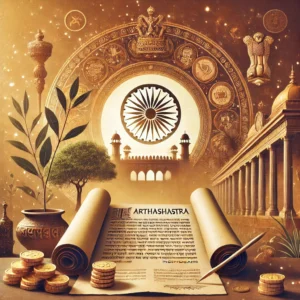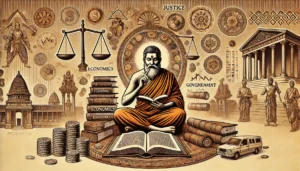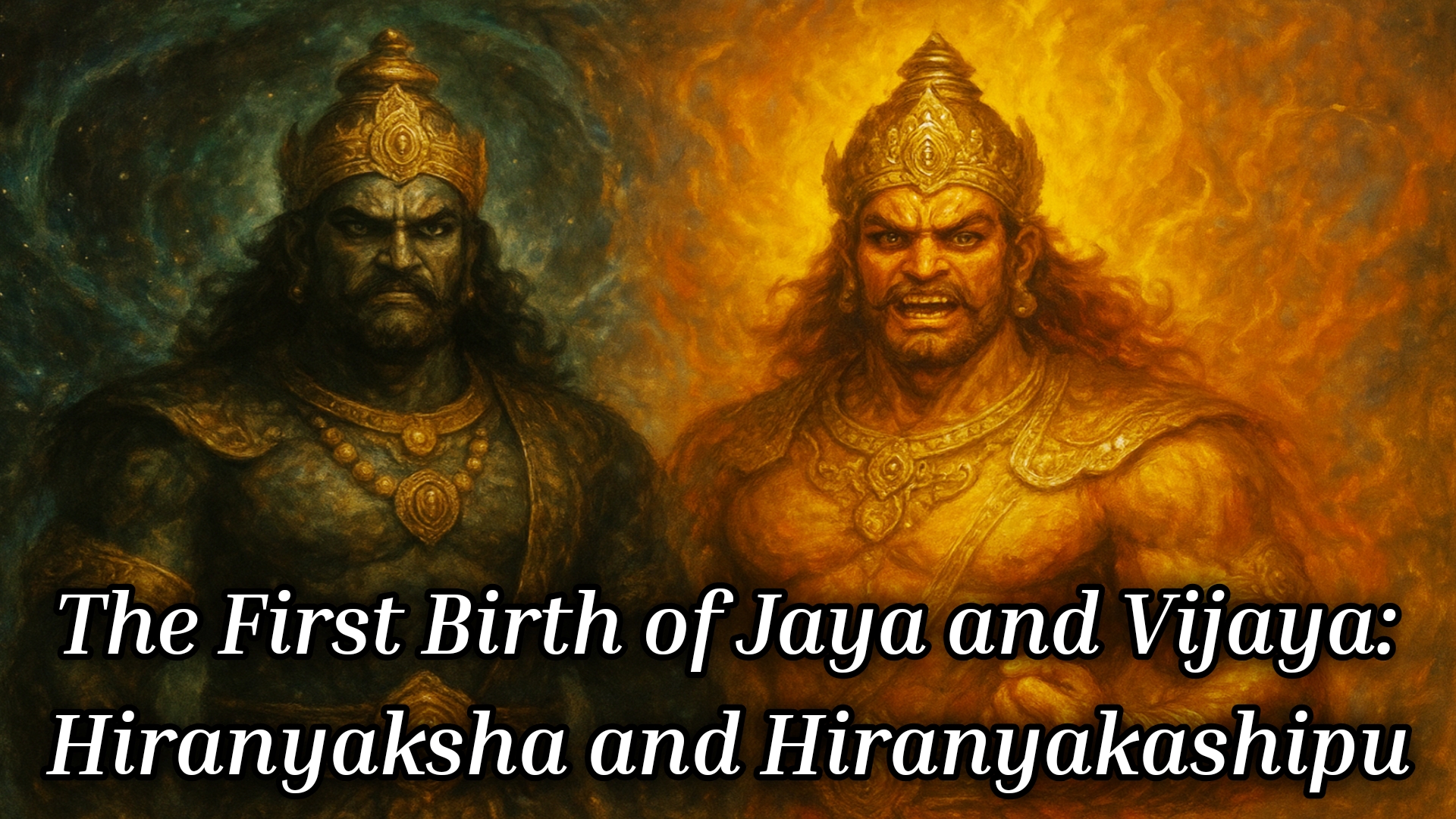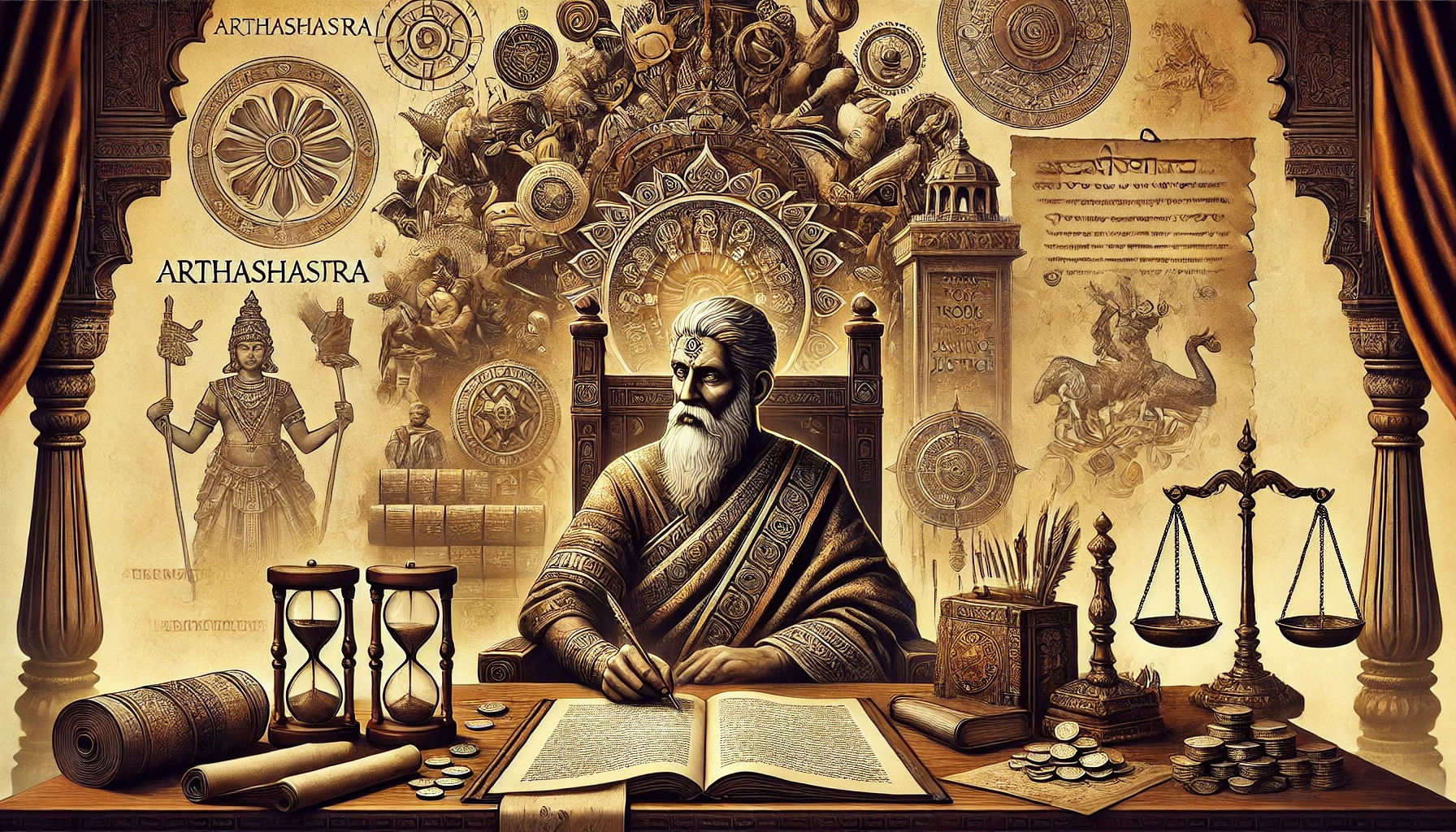
Lessons on economics from arthashastra
The Arthashastra: Lessons on Economics and Governance for Individuals
The Arthashastra, written by the brilliant strategist and thinker Chanakya (also known as Kautilya), is one of the foundational texts on economics, statecraft, and governance. Composed in ancient India during the Mauryan Empire, the treatise was initially designed as a manual for rulers to manage their kingdoms effectively. However, the principles of the Arthashastra extend far beyond its original audience. Its timeless wisdom provides practical lessons for individuals seeking guidance in economics, leadership, and personal governance in today’s complex world.
Wealth: A Pillar of Stability
The Arthashastra underscores the importance of artha (wealth) as one of the four primary goals of human life, alongside dharma (righteousness), kama (desires), and moksha (liberation). Wealth is presented not as an object of greed but as a vital means to ensure stability, meet obligations, and support societal well-being.
For modern individuals, this perspective translates into effective financial management. Building wealth through savings, investments, and entrepreneurship aligns with Chanakya’s idea of generating resources sustainably. It also encourages individuals to view money as a tool for security, freedom, and philanthropy, rather than merely a source of material satisfaction.
Table of Contents

Lessons on economics from arthashastra
Strategic Thinking for Long-Term Success
Chanakya’s Arthashastra is replete with examples of strategic planning. He advocates a forward-thinking approach where actions are based on careful analysis of potential risks and rewards. The text emphasizes creating contingencies and using resources wisely to achieve long-term objectives.
For individuals, this is a lesson in goal setting and decision-making. Whether it is career planning, business strategy, or personal development, the ability to think strategically, anticipate challenges, and remain adaptable is crucial. Modern tools like SWOT analysis, risk assessment, and time management align seamlessly with Chanakya’s teachings.
Self-Discipline: The Foundation of Personal Governance
According to the Arthashastra, a ruler’s ability to govern effectively stems from self-discipline and personal integrity. A leader who lacks discipline cannot expect to command respect or manage their kingdom efficiently.
This principle applies universally to individuals in their personal and professional lives. Self-discipline is the cornerstone of achieving goals, maintaining health, and building relationships. From sticking to a fitness routine to meeting deadlines, disciplined behavior shapes one’s ability to succeed and lead.
Building and Nurturing Relationships
In the Arthashastra, Chanakya places significant emphasis on alliances, diplomacy, and understanding the motives of others. He advises rulers to maintain good relationships with allies, neutralize potential enemies, and act with foresight in all interactions.
For individuals, this translates into the importance of networking and fostering meaningful relationships. Whether it’s in personal life or professional settings, trust and collaboration often lead to opportunities and support during difficult times. Developing emotional intelligence, practicing empathy, and communicating effectively are modern equivalents of Chanakya’s diplomatic strategies.

Lessons on economics from arthashastra
Resilience and Crisis Management
The Arthashastra outlines methods to handle crises, whether internal rebellions or external threats. Chanakya’s advice includes staying calm, analyzing the situation thoroughly, and using resources efficiently to mitigate risks.
In today’s world, individuals face crises in various forms—financial instability, health emergencies, or career setbacks. The ability to remain adaptable, resourceful, and composed is critical. Chanakya’s teachings remind us that challenges are inevitable, but resilience and adaptability can turn adversity into opportunity.
Ethical Leadership and Responsibility
While the Arthashastra advocates pragmatism, it also underscores the importance of ethical governance. A ruler must act in the interest of their people, balancing power with responsibility and making decisions that benefit the greater good.
In individual terms, this means acting with integrity, especially in leadership roles. Whether managing a family, team, or community, ethical behavior fosters trust, respect, and long-term success. Modern leaders can learn from Chanakya’s emphasis on transparency, accountability, and fairness.
Education and Knowledge: The Ultimate Asset
Chanakya was a firm believer in the power of education and knowledge. The Arthashastra repeatedly emphasizes the role of learning in shaping capable leaders and individuals.
For individuals, continuous learning and self-improvement remain vital. In an era of rapid technological and social changes, staying informed and acquiring new skills are crucial for personal and professional growth. Chanakya’s belief in knowledge as a cornerstone of power encourages individuals to invest in education and lifelong learning.
Balancing Personal and Social Responsibilities
The Arthashastra advises rulers to maintain a balance between their personal needs and their responsibilities to the state. Similarly, individuals today can learn to balance personal ambitions with social obligations. Contributing to the welfare of society—through volunteering, mentorship, or philanthropy—enhances both personal fulfillment and societal progress.
Conclusion
The Arthashastra is a timeless guide that transcends its historical context to offer valuable lessons for individuals in every era. Its teachings on wealth management, strategic thinking, self-discipline, relationship building, crisis management, ethical leadership, and lifelong learning remain deeply relevant.
In a world characterized by rapid changes and increasing complexities, the wisdom of Chanakya serves as a beacon for navigating personal and professional challenges. By applying the principles of the Arthashastra, individuals can create a harmonious balance between personal success and societal contribution, ensuring a life of purpose, prosperity, and integrity.
Chanakya’s work reminds us that true governance begins within, and by mastering ourselves, we can influence the world around us for the better. The Arthashastra thus becomes not just a guide for rulers, but a manual for anyone striving to lead a meaningful and impactful life.

Lessons on economics from arthashastra
FAQs on “Mastering Economics and Governance: Timeless Lessons from The Arthashastra”
- What is “The Arthashastra”?
“The Arthashastra” is an ancient Indian treatise attributed to Chanakya (Kautilya), a strategist, economist, and political thinker who was instrumental in the establishment of the Maurya Empire. The text outlines principles of statecraft, economic management, governance, diplomacy, military strategy, and ethics, making it one of the oldest comprehensive guides to governance and leadership.
- What is the purpose of this book?
This book reinterprets “The Arthashastra” to make its timeless teachings accessible to a modern audience. It focuses on how individuals can apply these lessons to economics, governance, and personal development in today’s world. By distilling complex ancient concepts, the book aims to provide actionable insights for both personal and professional growth.
- Who is the target audience for this book?
The book caters to a diverse audience, including:
Professionals in economics, management, leadership, or public policy.
Students of history, political science, and governance.
Leaders and entrepreneurs looking for strategic and ethical decision-making guidance.
Anyone curious about ancient wisdom and its relevance to contemporary challenges.
- What topics are covered in the book?
The book is organized around key themes such as:
Economic Principles: Wealth creation, resource allocation, and financial management.
Leadership and Decision-Making: Building strategic vision, ethical leadership, and effective problem-solving.
Governance and Administration: Crafting policies, managing organizations, and fostering stability.
Military and Diplomatic Strategies: Defense planning, conflict resolution, and negotiation tactics.
Ethics and Morality: Balancing power with principles and ensuring fairness in leadership.
- How are the lessons from “The Arthashastra” relevant to modern life?
Although written over 2,000 years ago, the lessons in “The Arthashastra” remain highly relevant today. The principles of strategic planning, efficient resource management, ethical governance, and adaptive leadership resonate in fields like business management, public administration, and personal decision-making. The book demonstrates how ancient strategies can help address contemporary challenges.
- Do I need prior knowledge of “The Arthashastra” to read this book?
No, the book is designed to be accessible to everyone, including those unfamiliar with “The Arthashastra.” It provides context and explanations to make the ancient teachings understandable and relatable to modern readers.
- Can the lessons be applied to personal growth?
Absolutely. Many teachings focus on personal discipline, strategic thinking, and ethical conduct. These principles are as applicable to personal development and self-improvement as they are to governance or business.
- How is this book different from other interpretations of “The Arthashastra”?
This book uniquely focuses on bridging the gap between ancient wisdom and modern applications. While retaining the essence of the original text, it emphasizes practical insights that readers can directly implement in their lives, careers, and leadership roles.
- What are some key takeaways from the book?
Strategic planning and adaptability are critical to success.
Economic stability is the foundation of societal well-being.
Ethical leadership fosters trust and long-term success.
Diplomacy and negotiation often triumph over conflict.
Continuous learning and self-discipline are vital for personal and professional growth.
- What makes “The Arthashastra” significant in history?
“The Arthashastra” is one of the earliest and most comprehensive treatises on governance and economics. It laid the foundation for statecraft and economic thought in ancient India, influencing rulers and scholars for centuries. Its emphasis on pragmatism, ethics, and foresight continues to inspire leaders worldwide.
- Is this book suitable for academic study?
Yes, the book serves as a resource for students and researchers in fields like history, economics, political science, and leadership studies. Its accessible language and practical focus make it a valuable supplement to academic discussions on governance and strategy.
- Does the book offer modern examples to complement the ancient teachings?
Yes, the book frequently draws parallels between Chanakya’s principles and contemporary scenarios in business, politics, and personal life. By blending historical context with modern examples, it ensures the lessons remain relatable and actionable.
- Can leaders and entrepreneurs benefit from this book?
Absolutely. The book offers valuable insights into strategic thinking, team management, decision-making, and resource optimization—essential skills for leaders and entrepreneurs. It also emphasizes the importance of ethical conduct and long-term planning for sustainable success.
- How can I purchase the book?
The book is available in both physical and digital formats at major bookstores and online retailers. You can also find it on platforms like Amazon, Barnes & Noble, and other e-commerce sites.
- Why should I read this book?
If you’re looking to deepen your understanding of leadership, economics, and governance through timeless principles that transcend cultures and eras, this book is a must-read. It combines ancient wisdom with practical advice, making it a valuable guide for personal and professional development.
Summary
“Mastering Economics and Governance: Timeless Lessons from The Arthashastra”
This book revisits The Arthashastra, the ancient Indian treatise written by Chanakya (Kautilya), which offers profound insights into economics, governance, and statecraft. By reinterpreting its principles for modern audiences, the book bridges the gap between ancient wisdom and contemporary practices.
Key themes include:
Economic Management: Practical strategies for wealth creation, resource allocation, and trade regulation.
Governance: The art of leadership, administration, and the ethics of ruling.
Strategy and Diplomacy: Techniques for conflict resolution, alliance-building, and strategic decision-making.
Personal Growth: How individuals can apply principles of discipline, foresight, and adaptability to personal and professional contexts.
By integrating these lessons, the book empowers readers to cultivate strategic thinking, achieve economic stability, and lead with integrity in both personal and societal domains.
Lessons for Individuals
- Financial Planning
- Invest in education, skills, and businesses to secure long-term growth.
- Avoid wastefulness, as prosperity depends on the careful management of resources.
- Diversify income streams to mitigate risks.
2. Personal Governance
- Practice self-discipline to achieve personal goals.
- Balance ambition with ethical behavior to maintain integrity and reputation.
3. Relationship Management
- Apply diplomacy in personal and professional relationships.
- Build alliances and foster goodwill, as collaboration often yields better outcomes than conflict.
4. Adaptability
- Embrace change and tailor strategies to suit evolving challenges.
- Use foresight to anticipate risks and opportunities.
5. Service to Society
- Recognize the interconnectedness of individual and societal well-being.
- Contribute to community development as a form of personal growth and legacy building.
Modern Relevance
While the Arthashastra primarily addresses kings and rulers, its principles transcend time and apply to individuals navigating today’s complexities. Its focus on economics, strategic thinking, and ethics makes it a valuable guide for personal and professional development.
In essence, The Arthashastra is not just a manual for governance but also a blueprint for leading a balanced, prosperous, and meaningful life. Its teachings urge individuals to think critically, act ethically, and plan strategically, ensuring success while contributing positively to society.
Related Articles
- The Tridevi: Lakshmi, Saraswati, and Parvati – Their Roles and Powers
- “Divine Creatures of Ancient Indian Scriptures: Exploring the Role of Animals in the Vedas, Puranas, and Mahabharata”
- Nature and Spirituality: Exploring the Sacred Essence of the Himalayas, Ganga, and Other Natural Wonders”
- “Reviving the Gurukul System: Relevance and Lessons for Modern Education”
- “Exploring Greek and Indian Mythology: Similarities Between Greek and Indian Mythology “
- “Embracing Sattvic Living: Harmonizing Mind, Body, and Soul Through Food and Lifestyle”
- “Charity and Prosperity: Exploring the Concept of Daan and Its Financial Relevance in Modern Life”
- How to Build an Eco-Friendly Home Inspired by Vastu Shastra
- Comparison of Ancient and Modern Sports: How Traditional Sports Have Influenced Contemporary Games
- “Timeless Lessons from Ancient Tales: Linking Samudra Manthan and Ganga’s Descent to Modern Ecological Challenges”
- “Reviving Sanskrit: How AI is Preserving Ancient Languages for the Future”
- “Mathura: The Sacred Land of Lord Krishna’s Divine Leelas”
- Investing for Future Generations: Lessons from Indian Traditions on Legacy Building and Wealth Preservation
- “Ancient Indian Wisdom: Timeless Lessons for Tackling Today’s Climate Crisis”
- “Artificial Intelligence and Spirituality: Transforming Ancient Practices for the Modern World”
- “Gold and Real Estate in India: Timeless Assets Shaping Financial Strategies”
- “Divine Feminine Power in Hindu Mythology: The Legends of Durga, Saraswati, and Lakshmi”
- “Divine Beings of Sanatan Dharma: The Spiritual Significance of Sacred Animals in Hinduism”
- “Symbolism in Mythological Art: Unlocking Hidden Meanings in Ancient Temple Carvings”
- “Exploring Technological Advancements in Ancient India and Civilizations: Vimana, Metallurgy, & Water Management systems”
- Unveiling the Mysteries: Ancient Temples of Sanatan Dharma , Mysterious Temples of India
- “The Scientific Knowledge of Sanatan Dharma: Ancient Wisdom Meets Modern Science”
- Ancient Indian Sports and Games: Celebrating a Legacy of Skill, Strength & Strategy”
- “Exploring the Cosmic Link: The Connection Between Astronomy and Vedic Astrology”
- The Power of Sanskrit: Unlocking the Divine Language of the Gods
- “The End of Kaliyuga: A Sanatan Insight into the World’s Final Chapter”
- Explore more articles on Prachin Sanatan Yuga.
-
The Third Birth of Jaya and Vijaya: Shishupala and Dantavakra

The Third Birth of Jaya and Vijaya 🕉️ How the Fiercest Enemies of Krishna Returned as His Eternal Devotees The grand theatre of Sanatan Dharma holds stories where even conflict becomes a sacred bridge to salvation. Among the most unforgettable of these cosmic dramas is the tale of Jaya and Vijaya, the revered gatekeepers of…
-
The Second Birth of Jaya and Vijaya: Ravana and Kumbhakarna

The Second Birth of Jaya and Vijaya: Ravana and Kumbhakarna In the endless cycle of creation and dissolution, every soul — even the most divine — experiences the law of karma and destiny. Among the most profound stories in Sanatan Dharma is that of Jaya and Vijaya, the revered gatekeepers of Vaikuntha, whose devotion to…
-
The First Birth of Jaya and Vijaya: Hiranyaksha and Hiranyakashipu

The First Birth of Jaya and Vijaya: Hiranyaksha and Hiranyakashipu In Hindu mythology, Jaya and Vijaya are the revered gatekeepers of Vaikuntha, the celestial abode of Lord Vishnu. Known for their unwavering devotion and courage, these divine guardians are more than just protectors—they play an essential role in maintaining the cosmic order. However, a fateful…
The Arthashastra, authored by Kautilya (also known as Chanakya), is a timeless treatise on statecraft, economics, and governance that continues to resonate with individuals and societies alike. Written around 4th century BCE, the text provides a comprehensive guide to managing resources, building wealth, and governing effectively, offering principles that remain relevant in the modern era.
The Arthashastra, authored by Kautilya (also known as Chanakya), is a timeless treatise on statecraft, economics, and governance that continues to resonate with individuals and societies alike. Written around 4th century BCE, the text provides a comprehensive guide to managing resources, building wealth, and governing effectively, offering principles that remain relevant in the modern era.
Lessons on economics from arthashastra Lessons on economics from arthashastra Lessons on economics from arthashastra Lessons on economics from arthashastra Lessons on economics from arthashastra Lessons on economics from arthashastra
